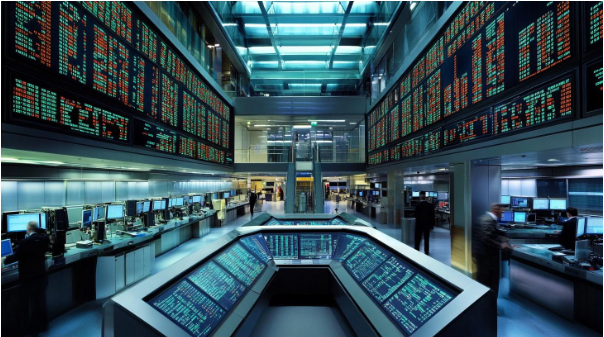How Many Stocks Are Listed on the London Stock Exchange?

Global investors recognize the London Stock Exchange as a pivotal financial marketplace with a rich heritage. Since 1801, this dynamic platform has facilitated capital access for diverse businesses. Understanding market dynamics, such as tracking aviva share price, remains crucial for strategic investment approaches in this internationally significant trading environment.
Historical evolution
In the bustling streets of 18th-century London, a financial revolution was quietly brewing. The London Stock Exchange (LSE) wasn’t born in a gleaming skyscraper, but in the smoky, chaotic coffee houses of the City, where merchants and traders would gather to exchange not just commodities, but dreams of economic transformation.
From coffee houses to global marketplace
Picture a typical day in 1760: Jonathan’s Coffee House on Change Alley. Traders huddle around makeshift tables, scribbling notes, shouting prices, and making deals that would reshape the global economy. This wasn’t just trading—it was the raw, unfiltered birth of modern financial markets.
In 1801, what began as informal gatherings became formalized. The LSE emerged not as a sudden invention, but as an organic evolution of Britain’s commercial genius. It was a time when the British Empire was expanding, and financial innovation became as crucial as naval power.
Technology of trade
By the late 19th century, the LSE was more than a marketplace—it was a technological marvel. The introduction of the telegraph transformed trading from a local to a global phenomenon. Prices that once took weeks to communicate could now travel in moments, shrinking the world’s financial distances.
The LSE wasn’t just adapting to change; it was driving it. When other markets were still using handwritten ledgers, London was pioneering electronic trading systems that would become the global standard.
Current listings
Total number of stocks
As of the latest update, the London Stock Exchange hosts approximately 618 active stocks. This figure highlights the LSE’s significant role in the global financial landscape, serving a diverse range of sectors and industries.
Distribution of listings
The LSE categorizes its listings across several market segments:
- Main Market: Home to the largest and most established companies, this segment includes those that meet stringent regulatory requirements.
- AIM (Alternative Investment Market): Known for its more flexible regulatory system, the AIM supports smaller, growing companies.
- Specialist Fund Market: Tailored for highly specialized investment entities such as venture capital trusts.
Historical trends in listings
The number of listings on the LSE has seen fluctuations influenced by various factors such as economic cycles, regulatory changes, and market sentiment. Over the years, the LSE has maintained its appeal, adapting to the needs of modern businesses and investors through innovation and regulatory evolution.
Inside the LSE listing process
Imagine a rigorous, almost theatrical selection process where companies aren’t just admitted—they’re vetted, scrutinized, and ultimately transformed. The London Stock Exchange’s listing mechanism is less a procedure and more a financial crucible where only the most robust businesses survive.
The multilayered screening
For a company, getting listed on LSE isn’t just about having a compelling business model. It’s about passing through a labyrinth of regulatory checkpoints that would make even the most seasoned corporate executives break into a cold sweat.
The process begins with an intricate due diligence that goes far beyond traditional financial audits. LSE doesn’t just look at numbers—they dissect corporate governance, assess long-term sustainability, and evaluate a company’s potential systemic impact on the market.
Unique listing tiers
Unlike many exchanges, LSE offers a nuanced approach:
- Premium Segment: The pinnacle of corporate excellence, reserved for companies with impeccable transparency
- Standard Segment: For businesses meeting core regulatory requirements
- Specialized Segments: Tailored routes for specific types of enterprises, from emerging tech startups to complex financial instruments
The human element
Behind every listing is a complex human narrative. LSE’s experts aren’t just number-crunchers—they’re economic anthropologists who understand that each company represents more than a balance sheet. They’re looking for stories of innovation, resilience, and potential global impact.
Sector and regional breakdown
Sector analysis
The London Stock Exchange’s listings cover a broad spectrum of sectors:
- Financials: Banks, investment funds, and insurance companies.
- Industrials: Includes construction, engineering, and manufacturing firms.
- Consumer Goods: Companies producing food, beverages, and other retail products.
This sector diversity allows investors to spread their risks and opportunities across different market conditions.
Geographic diversity
While a majority of the companies listed on the LSE are based in the UK, a significant number of international firms also choose the LSE for their primary or secondary listings. This global presence not only enhances the liquidity of the LSE but also its appeal to international investors seeking exposure to different geographic markets.
Challenges and trends affecting stock listings
Regulatory impacts
The regulatory environment in the UK has seen significant shifts, particularly following Brexit. These changes affect how companies are listed and regulated on the LSE. For instance, new rules and agreements are continually being forged to ensure that the LSE remains a competitive landscape in the face of evolving international trade and finance regulations.
Technological advances
The adoption of technology in trading platforms has revolutionized how stocks are listed and traded on the LSE. The integration of digital systems has led to increased efficiency but also poses challenges such as cybersecurity risks and the need for constant technological upgrades to keep up with global standards.
Future outlook
Looking ahead, the London Stock Exchange is poised to continue its legacy as a leading global financial market. Several factors will play a crucial role in shaping its trajectory:
- Growth in Emerging Markets: As more companies from rapidly growing economies seek global exposure, the LSE might see an increase in listings from these regions.
- Technological Innovations: Continued advancements in fintech and blockchain could transform the traditional mechanisms of stock trading and listings, potentially opening new opportunities for the LSE.
- Regulatory Developments: Post-Brexit regulatory adjustments will likely continue to influence the market dynamics of the LSE, affecting both UK-based and international companies.
Conclusion
The London Stock Exchange remains a cornerstone of the global financial system, reflective of its rich history and its ability to adapt to changing market conditions. For investors and traders, both within the UK and globally, understanding the diverse and dynamic nature of the LSE is essential for making informed investment decisions. As the market evolves, keeping abreast of the number and type of listings will be crucial in navigating the complexities of modern financial environments.



